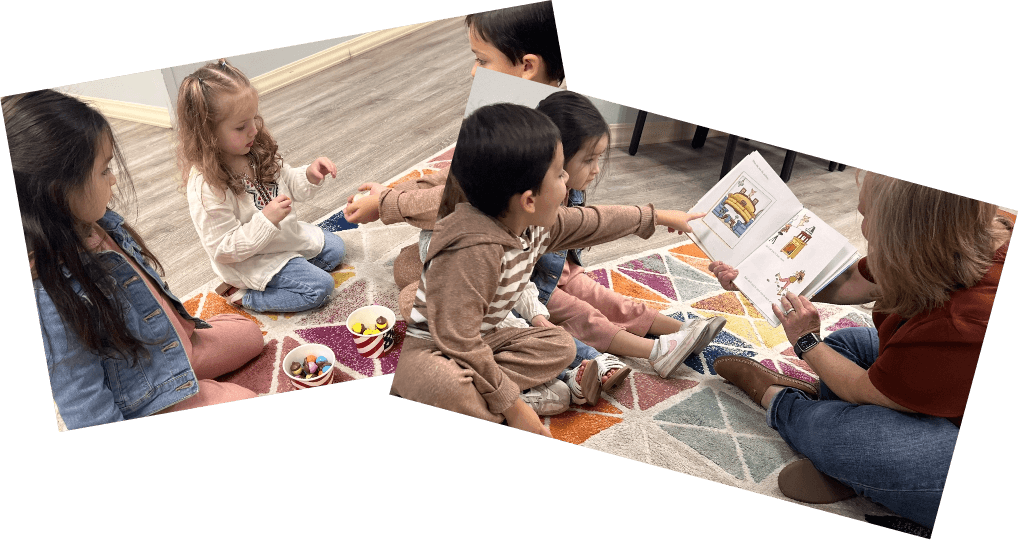What We Offer

What We Do
Speech/Articulation
Articulation is the production of speech sounds. A child begins speaking between 9-12 months of age. Speech sound production develops and becomes more refined between ages 1-6. A general rule of thumb is that by age 2, a stranger should understand 50% of a child’s speech, 75% by age 3 and 100% by age 4. Articulation should be evaluated and treated at an early age to prevent frustration and potential reading issues.
Language
Language skills can be separated into receptive skills (what a child understands) and expressive skills (a child’s ability to express their thoughts, wants, and needs). Language development begins before birth and continues throughout childhood. A child with a receptive language impairment may have difficulty following directions, answering questions, comprehending an age-appropriate story or conversation or identifying vocabulary. A child with an expressive language impairment may not be speaking at all or may be using one or two word phrases when other children his/her age are using complete sentences. A child with an expressive language impairment may also struggle to use a variety of vocabulary words or effectively communicate their wants and needs. Children struggling with language development should be evaluated as early as possible since treatment is most effective in the early years.
Fluency
Fluency refers to stuttering or the uninterrupted flow of speech. Stuttering includes repetitions of sounds within words, repeating words multiple times within a sentence, or obvious pauses within a sentence or conversation. Many children stutter between 3-5 year of age as their language skills are developing at a rapid rate. This type of stuttering is normal and usually lasts a few months. Stuttering that persists longer than 6 months or causes great frustration should be evaluated.
Dyslexia
Dyslexia is a neurobiological disorder that is characterized by difficulties in reading, writing and spelling. These difficulties result from a deficit in the phonological component of language and are present despite average to above average cognitive abilities and effective classroom instruction. According to the Dyslexia Research Institute, approximately 10-15% of the US school population has dyslexia, however only 5% of students with dyslexia are properly identified and given support. An estimated 60% of students diagnosed with ADHD also have dyslexia. Difficulties resulting from dyslexia become more and more apparent as a student moves through school, therefore early diagnosis and treatment is crucial to a child’s academic success and self-esteem.
Phonological and Phonemic Awareness
Phonological awareness is the ability to recognize that spoken words are made up of individual sound parts. This includes skills such as rhyming, alliteration, segmenting words into syllables, and identifying beginning and ending sounds in a word. Phonemic awareness is the most advanced skill of phonological awareness and involves the ability to hear, identify and manipulate sounds within a word. These skills are the foundation of reading and must be evaluated and treated as early as possible to minimize reading struggles throughout the school years.
Social Language Disorder/Pragmatics
Pragmatics refers to the socially appropriate use of verbal and nonverbal language. Children with a social language disorder may have difficulties knowing what to say, how to say it and when to say it. They may have difficulty using language for a specific purpose, changing their language depending on the person they are speaking to or the situation that they are in, and following appropriate social rules for communication (staying on topic, taking turns, understanding body language). Children with a pragmatic language disorder often process language literally and may have difficulty understanding what others are trying to communicate. Social language disorders are common in children with a diagnosis of Autism Spectrum Disorder (ASD) or ADHD. Social Language Disorders should be evaluated and treated as early as possible to prevent social isolation and stress during social interactions.
Autism Spectrum Disorder/Asbergers (ASD)
ASD is a lifelong personality and learning difference that affects people in different ways and in varying degrees. Individuals with autism struggle with understanding what other people think and feel. They also have difficulty expressing themselves effectively both verbally and nonverbally. Children with ASD may have problems with learning. Their skills may develop unevenly and they often have a wide range of strengths and weaknesses. Signs of autism usually appear between birth and age 3. Common signs include a lack of eye contact, narrow range of interests or intense interest in certain topics, repetitive behavior, high sensitivity to sensory input, difficulty adapting to change in routines, and difficulty understanding and using language. Early intervention is critical. Children with ASD often need a variety of interventions including speech/language therapy to assist in language development, implementation of visual schedules, as well as other strategies to insure the best possible outcomes for the student and their family.
Augmentative and Alternative Communication (AAC)
Augmentative and Alternative communication (AAC) refers to any means of communication that is not verbal. AAC describes multiple ways to communicate, either temporarily or permanently, that either supplement or compensate for severe expressive language impairments. AAC methods include picture exchange systems, IPAD/tablet programs, or dedicated communication devices. A Speech Language Pathologist will usually attempt a variety of speech or language interventions before recommending an AAC evaluation.

Should I have my child evaluated?
Your child should be evaluated by a Speech Language Pathologist (SLP) any time that you, your pediatrician, or teachers have concerns in any of the following areas:
Understanding your child’s speech
Using age-appropriate sentence length
Answering questions
Following directions
Comprehending a story
Accurately expressing his/her thoughts and ideas
Following the social rules of communication
Stuttering/Fluency
Understanding letter/sound correspondence
Rhyming and/or manipulating sounds in words
Reading
Spelling
What Our Clients Have to Say
The progress we’ve seen in our son’s communication skills is incredible. He’s more confident and expressive now.
Sarah T., Proud Parent